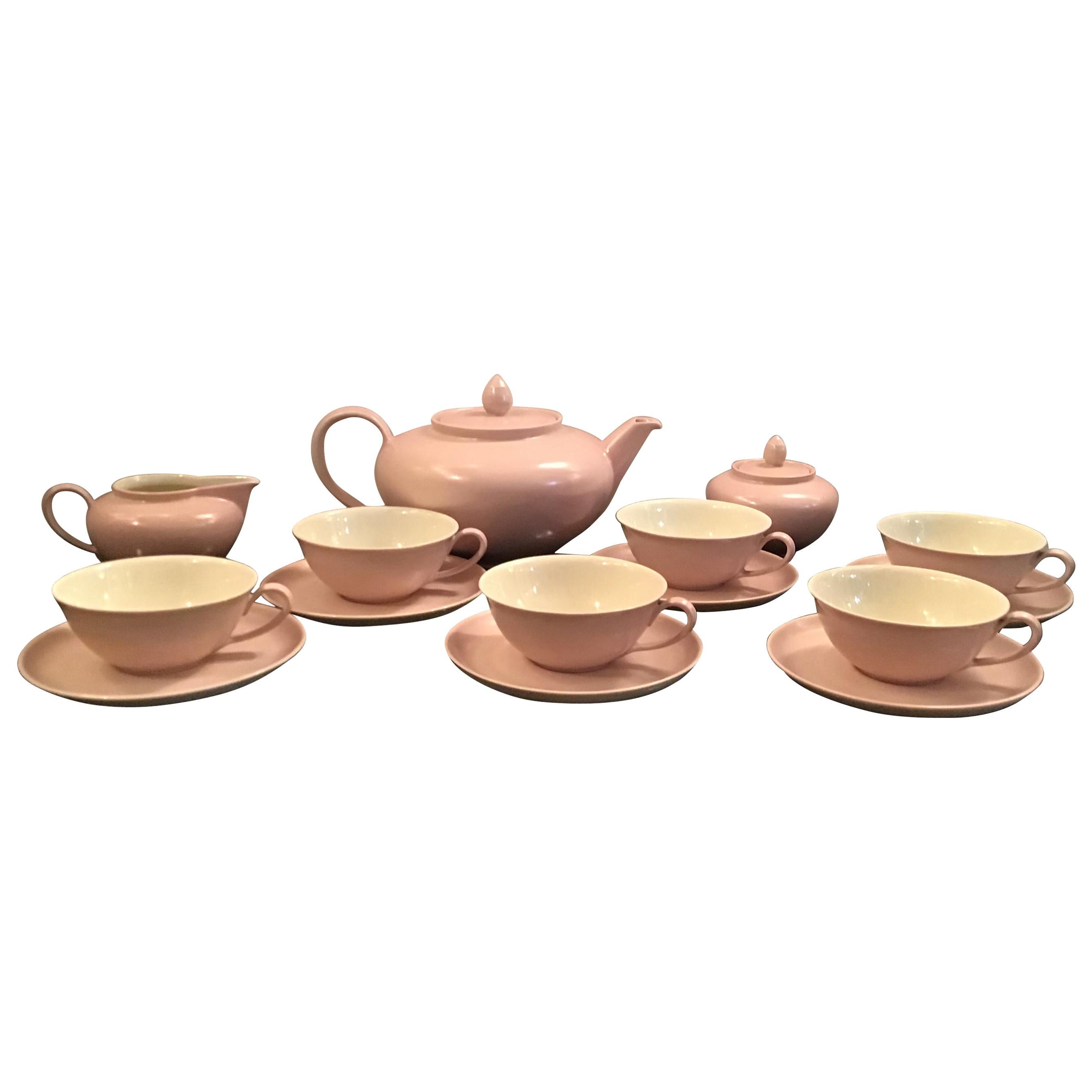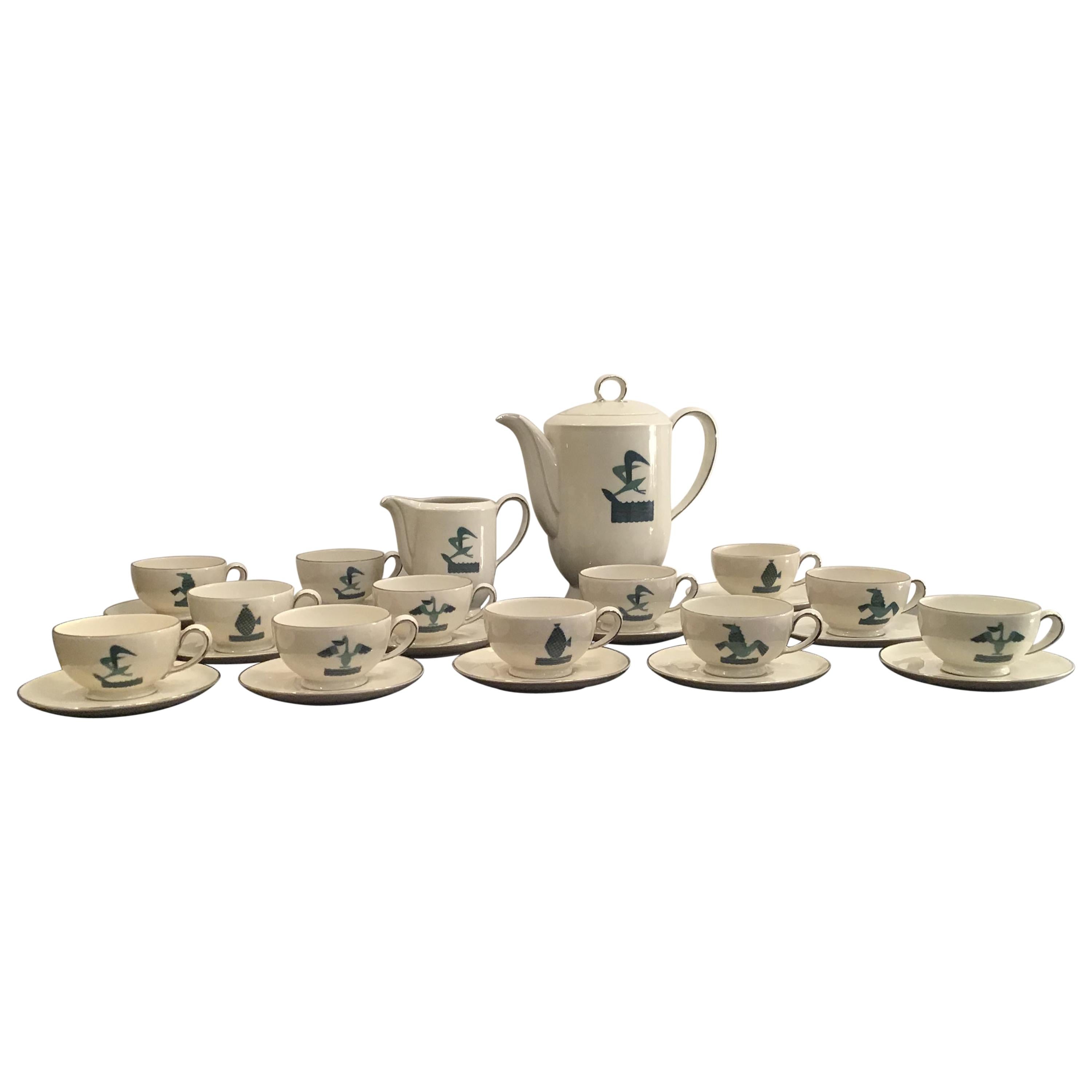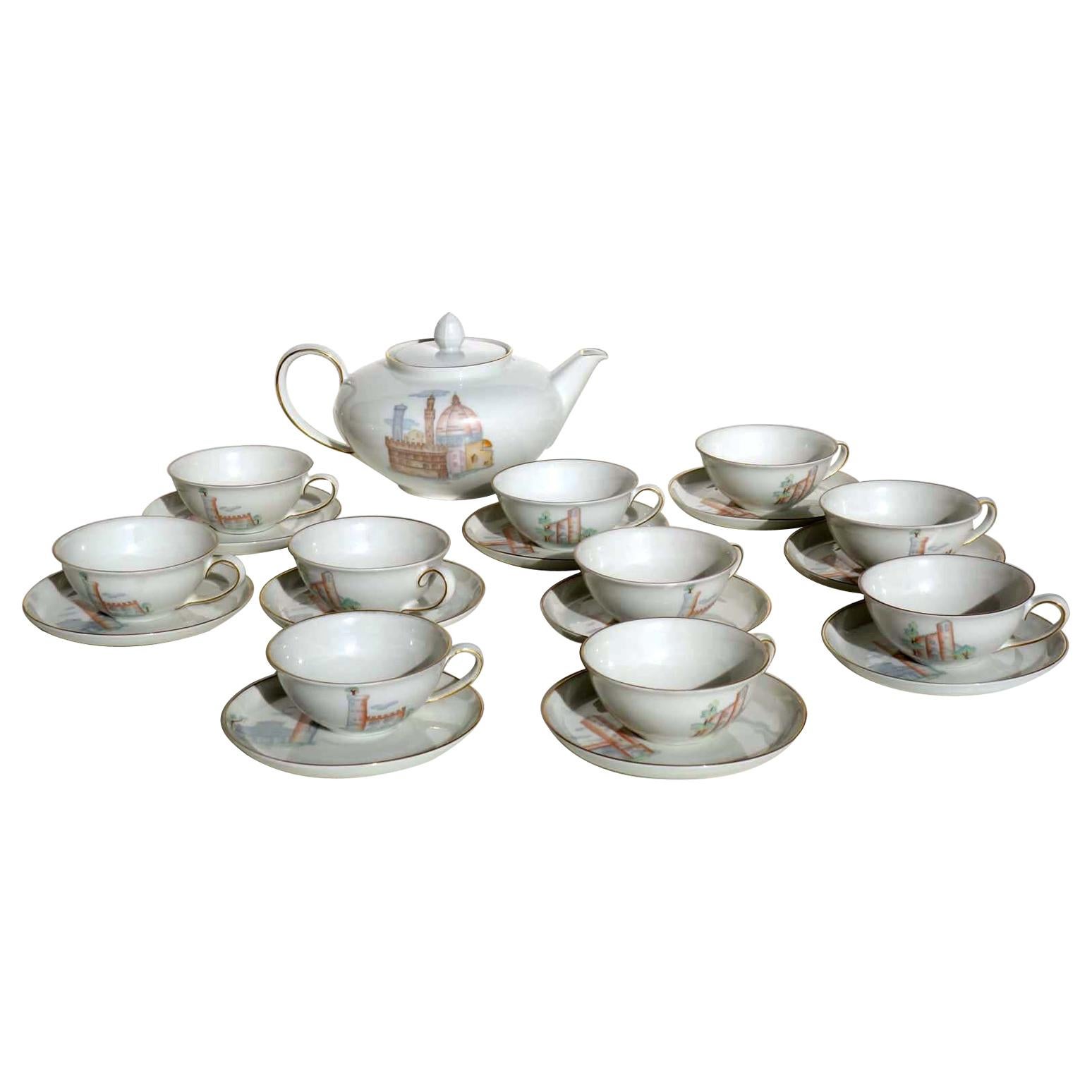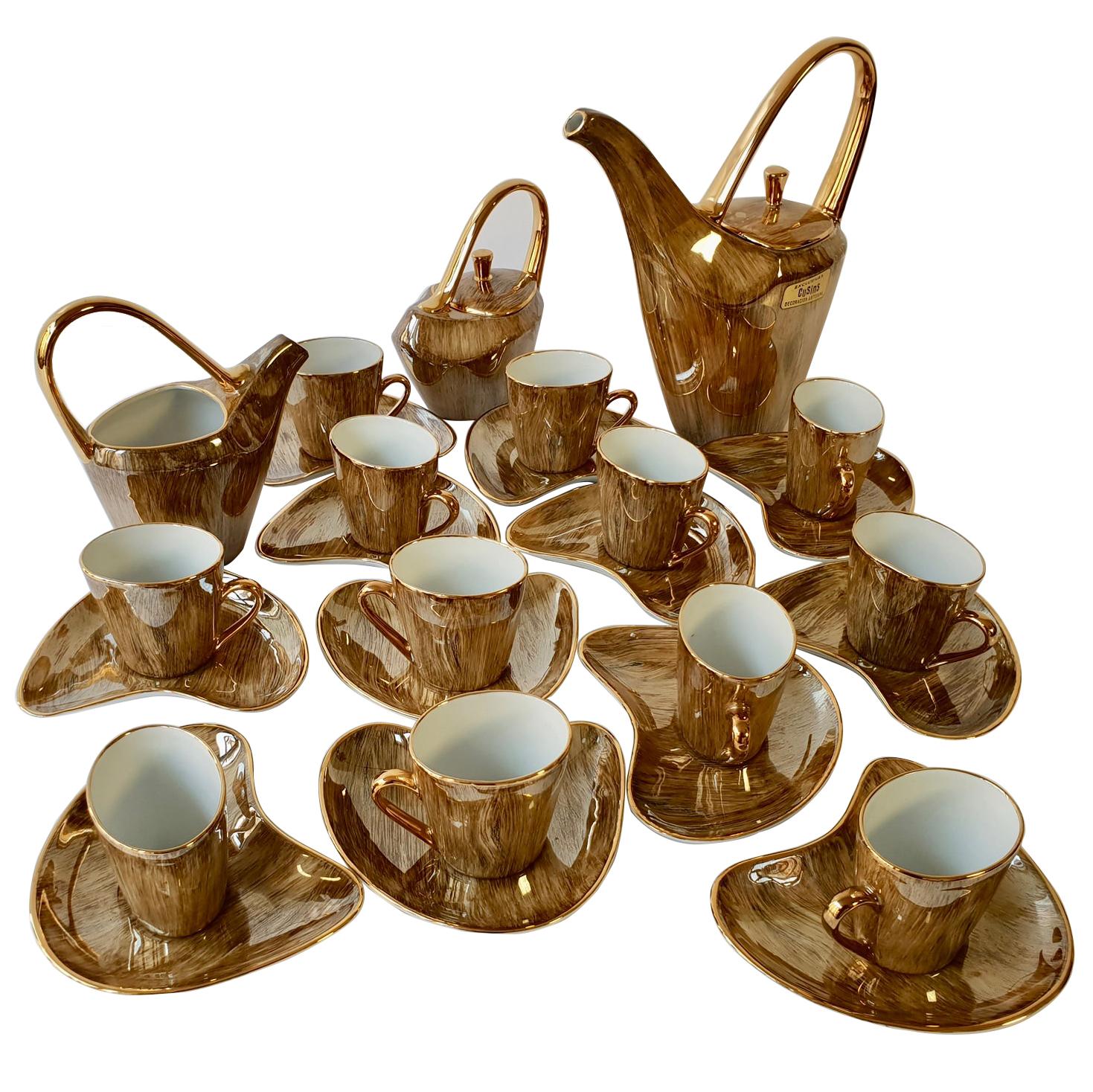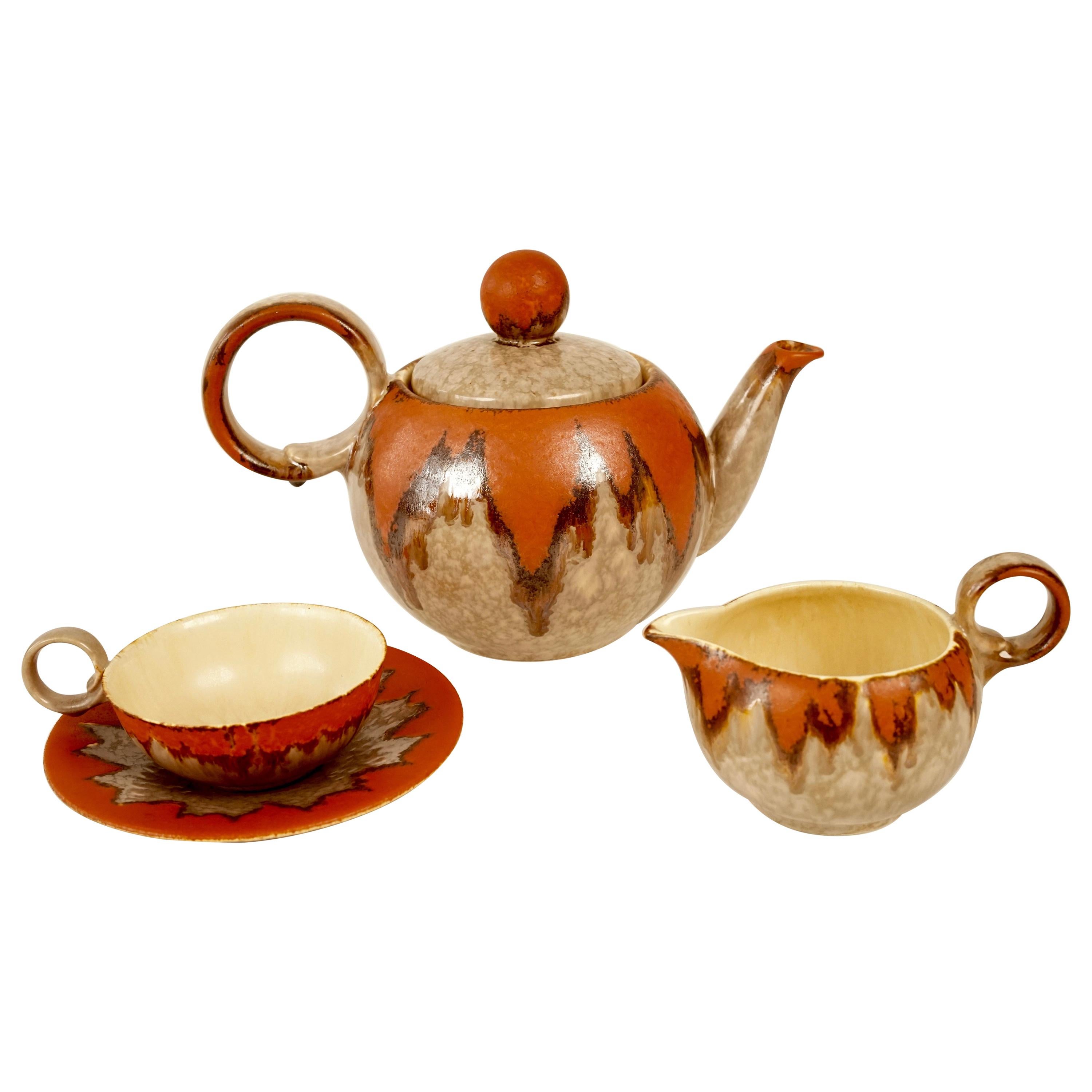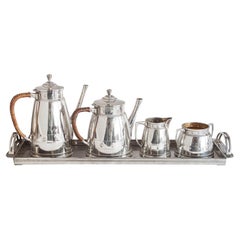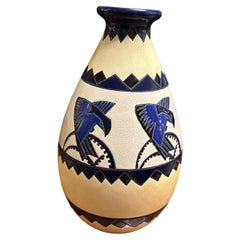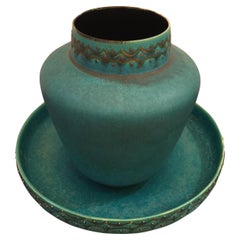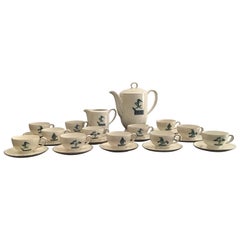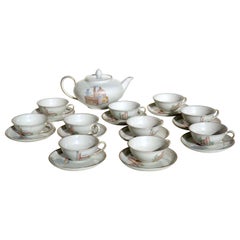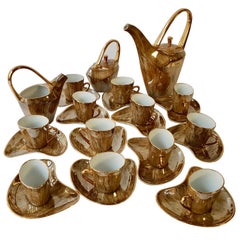Items Similar to English tea set, Name: Tango, Design: A. Susie Cooper, Style: Art Deco, 1933
Video Loading
Want more images or videos?
Request additional images or videos from the seller
1 of 22
English tea set, Name: Tango, Design: A. Susie Cooper, Style: Art Deco, 1933
$20,000per item
£15,113.34per item
€17,452.20per item
CA$27,946.98per item
A$31,009.53per item
CHF 16,243.46per item
MX$380,260.08per item
NOK 206,611.20per item
SEK 195,032.16per item
DKK 130,152per item
Quantity
Shipping
Retrieving quote...The 1stDibs Promise:
Authenticity Guarantee,
Money-Back Guarantee,
24-Hour Cancellation
About the Item
12 small plates : 14,5 cm diameter x 2,1 cm high
5,7 inch diameter x 0,82 inch high
12 medium plates: 17 cm diameter x 1,5 cm high
6,69 inch diameter x 0,59 inch high
2 large plate: 25,5 cm diameter x 2,5 cm high
10,03 inch diameter x 0.98 inch high
1 teapot: 19 cm high x 13 cm long x 14 cm diameter
0,74 inch high x 0,51 inch long x 0,55 inch diameter
1 milk jug: 11 cm high x 15 cm long x 12, cm diameter
0,43 inch high x 0,59 inch long x 0,47 inch diameter
sugar bowl: 15 cm long x 11 high x 11 cm diameter
0,59 inch long x 0.43 inch high x 0,43 inch diameter
The Life Of Susie Cooper, Ceramicist
Susie Cooper was a local lady, born in October 1902 in Burslem, Stoke-on-Trent. Susie was the youngest of seven children and from an early age she was a child with artistic flair who developed an interest in drawing. She began her art education at the Burslem School of Art where she attended night classes until she was awarded a scholarship that allowed here to attend school full time.
In 1922 Susie joined A.E. Gray & Co. Ltd, a ceramics firm based in Hanley in Staffordshire as a means to gain entry to the Royal College of Art. Whilst employed there, owner Albert Edward Gray recognised her talents as a designer and she was soon producing her hand painted floral designs that are still popular collector's items today. Susie's designs for the firm are recognisable due to the introduction of a special backstamp that incorporates Susie's name. Susie remained at A E Gray & Co Ltd as the company's Art Director until 1929, when she left the firm on her 27th birthday to establish her own pottery.
Susie left A E Gray & Co Ltd in order set up her own business - ‘Susie Cooper Potteries’ - as she wanted to design ceramic shapes in addition to designing and painting the décor and take greater control over the whole process. Her early bold designs were popular and her move to independence paid off, as she embarked on a long and successful career thereafter.
Upon a move to a new factory in 1931 to the Crown Works, Susie developed a new backstamp - the infamous leaping deer - to celebrate, which is a good indicator of date for pieces by Susie Cooper Potteries. In 1940 she was awarded ‘Royal Designer for Industry,’ a distinction established by the British Royal Society of Arts. This is awarded to those who have achieved “sustained excellence in aesthetic and efficient design for industry" and this was the first time that the award had been made purely for pottery design.
She established Susie Cooper China in 1950 when she purchased a china manufacturing business going on to produce the acclaimed Quail shape in the 1950s, and the popular Can shape in the 1960s. Susie worked for many other pottery firms over the years, including Wedgwood who she joined in 1966 when they acquired Susie Cooper China Ltd.
Susie Cooper also received an OBE in 1979 for her contribution to the arts. She retired at the age of 80 and died on the Isle of Man in 1995.
Susie Cooper was one of England’s most prolific and successful ceramic designers and her career spanned many years from the 1920s to the 1980s. Her work has become highly sought after and valued by collectors.
We have specialized in the sale of Art Deco and Art Nouveau styles since 1982.If you have any questions we are at your disposal.
Pushing the button that reads 'View All From Seller'. And you can see more objects to the style for sale.
Why are there so many antiques in Argentina?
In the 1880 – 1940 there was a grate wave of immigration encouraged by the periods of war that were taking place.
1st World War took place between 1914 and 1918
2nd World War took place between 1939 and 1945
The immigrants options were New York or Buenos Aires. Tickets were cheap and in Buenos Aires they were welcomed with open arms, as it was a country where everything was still to be done.
Argentina was the country of new opportunities, labour was needed and religious freedom was assured, in many cases the of the family travel first until they were settled and then the rest of the family members join them.
In the immigrant museum “Ellis Island Immigrant Building” in New York you can se the promotional posters of the boats that would take them to a new life.
Between the years 1895 and 1896, Argentina had the highest DGP (gross domestic product) per capita in the world according to the Maddison Historical Statistics index, this situation arose due to the large amount of food being exported to European countries, which were at war.
The Argentinean ships left the port of Buenos Aires with food, but they returned with furniture, clothes and construction elements, (it´s common to see this the old buildings of the historic neighbourhood of San Telmo, the beams with the inscription “Made in England)”, as well as many markets that were built in Buenos Aires, such us the San Telmo Market, whose structure was brought by ship and afterwards assembled in 900 Defensa Street.
With the great influence of European immigrants living in the country, the children of the upper classes travelled to study in France, resulting in the inauguration of “La Maison Argentinienne”, on 27th of June 1928, in the international city of Paris, which hosted many Argentinians that were studying in Frace.
It´s the fourth house to be built after France, Canada and Belgium, being the first Spanish-speaking one. Still in place today (17 Bd Jourdan, 75014, Paris, France). Many of the children of these wealthy families who attended international art exhibitions, museums and art courses abroad, took a keen interest in the European style. This is why Buenos Aires was at the time referred as “The Paris of South America”.
Between the years 1890 and 1920 more than a hundred Palaces were built on Alvear Avenue the most exclusive avenue in Buenos Aires. Today some of these palaces have been transformed into museums, hotels and embassies.
In the year 1936, the Kavanagh building was inaugurated, it was the tallest reinforced concrete building in South America.
During 1994 the American Society of Civil Engineers distinguished it as an “international engineering milestone”, and it´s now considered a World Heritage of Modern Architecture.
At the time was common to hire foreign architects such as Le Corbusier, who visited Buenos Aires/Argentina in 1929 and in 1948 he drew up the blueprints for a house built in La Plata City (which was declared a World Heritage Site).
In 1947, the Hungarian architect Marcelo Breuer designed “Parador Ariston” in the seaside city of Mar del Plata. After an Argentinean student at Harvard University convinced him to come to Argentina. He worked on an urban development project in the Casa Amarilla, area of La Boca.
The Ukrainian architect, Vladimiro Acosta, arrives in Argentina in 1928 and worked as an architect until que moved to Brazil.
Antonio Bonet, a Spanish architect who worked with Le Corbusier in Paris, arrives in Argentina in 1937, where he carried out several architectural works and in 1938 designs the well-known BFK chair.
Andres Kálnay, of Hungarian origin, made around 120 architectural masterpieces, among which the former Munich brewery stands out, he even made the furniture’s design.
The German architect, Walter Gropius, director of the Bauhaus, lived in Argentina, where he wrote articles for “Sur” magazine and founded in Buenos Aires, an architectural firm with Franz Möller, who was also an architect, where he built two houses.
At the same time several famous designers decided to immigrate to Argentina, among them we can find the well-known French designer, Jean-Michel Frank, who arrived in the country in 1940 and also worked for the Rockefeller family.
Special pieces were made, which were sold exclusively in the country, such as the well-known German company “WMF”, who sold their products by catalogue, which were chosen by the ladies of high society in the list of wedding gifts, as well as the pieces designed by Christofle.
The Swiss sculptor Alberto Giacometti, made special pieces for Argentinean mansions.
In 1904 the first Jansen branch outside Paris was established in Buenos Aires, as the Argentinean clientele demanded a large amount of furniture, from the end of the 19th century to the mid-20th century.
In 1970, the brand Rigolleau Argentina made pieces authorised by Lalique.
The brands Maple and Thompson also set up shop in the country.
The French plastic artist, Marcel Duchamp moved to Argentina in 1918-1919.
Glass signed Gallé, Charder, Leverre, Schneider, Muller and other French firms. They were bought in flower shops and were given to ladies with beautiful floral arrangements.
Some furniture manufacturers travelled to international fairs and bough the patterns to produce the furniture in Argentina, such as the furniture firm Englander and Bonta, who bought the patterns ins Italy.
It is worth mentioning that in Argentina we have the largest community of Italians outside of Italy, as it is estimated that 70 percent of the inhabitants have at least one Italian descendant, followed by Spanish immigrants.
The most Important furniture stores in Argentina:
Comte is founded in 1934 (under the direct management of Jean Michel Frank in 1940).
Nordiska (Swedish company established in 1934).
Churba in 1960, a company that brought foreign designers to present their furniture in the country:
Denmark: (Arne Jacobsen, Finn Juhl, Bender Madsen, Ejner Larsen, Poul Kjaerholm, Hans Wegner)
Sweden: (Hans Agne Jakobsson, Gustavsberg)
United States: (Herman Miller)
Finland: (Lisa Johansson, Folke Arstrom, Tapio Wirkkala, Alvar Aalto, Timo Sarpaneva)
Swedish Factory: (Orrefors)
Italy: (Littala, Vico Magistretti, Emma Gismondi, Gae Aulenti, Angelo Mangiarotti, Elio Martinelli, Gianna Celada, Angelo Mangiarotti, Mario Bellini, Carlo Scarpa)
Finland: (Olivia Toikka)
Plata Lappas (Lappas Silver): a goldsmith shop founded in 1887 in Argentina by Alcibiades Lappas of Greek origin.
In 2019, in Argentina took place “the Art Deco world congress”, in which we participated as hosts invited by Geo Darder, founder of the Copperbridge – Foundation, in which prominent people from all over the world attended to learn about Art Deco in Argentina.
Argentina currently has more than 100 Art Deco buildings and another 90 Art Nouveau buildings throughout the city of Buenos Aires.
Argentina is a country that has not been involved in many wars, which is why it has been a refuge for works of art and antiques from different periods of time, unlike European countries. That is way many collectors, museums and antique dealers from all over the world visit it, you should not miss the opportunity to visit this great country.
Laura Guevara Kjuder, architect.
- Creator:Susie Cooper (Designer)
- Dimensions:Height: 7.49 in (19 cm)Diameter: 5.52 in (14 cm)
- Style:Art Deco (Of the Period)
- Materials and Techniques:
- Place of Origin:
- Period:
- Date of Manufacture:1933
- Condition:Wear consistent with age and use.
- Seller Location:Ciudad Autónoma Buenos Aires, AR
- Reference Number:Seller: F-TO-1stDibs: LU6785237643512
About the Seller
5.0
Vetted Professional Seller
Every seller passes strict standards for authenticity and reliability
Established in 1982
1stDibs seller since 2022
37 sales on 1stDibs
Typical response time: <1 hour
- ShippingRetrieving quote...Shipping from: Ciudad Autónoma Buenos Aires, Argentina
- Return Policy
Authenticity Guarantee
In the unlikely event there’s an issue with an item’s authenticity, contact us within 1 year for a full refund. DetailsMoney-Back Guarantee
If your item is not as described, is damaged in transit, or does not arrive, contact us within 7 days for a full refund. Details24-Hour Cancellation
You have a 24-hour grace period in which to reconsider your purchase, with no questions asked.Vetted Professional Sellers
Our world-class sellers must adhere to strict standards for service and quality, maintaining the integrity of our listings.Price-Match Guarantee
If you find that a seller listed the same item for a lower price elsewhere, we’ll match it.Trusted Global Delivery
Our best-in-class carrier network provides specialized shipping options worldwide, including custom delivery.More From This Seller
View AllArt Deco Full Side Tea and Coffe Service, Made in Argentina, Sign Atenea, 1920
Located in Ciudad Autónoma Buenos Aires, C
Full side tea and coffe service
Sign: Atenea
materials: silver plated and wood
We have specialized in the sale of Art Deco and Art Nouveau and Vintage styles since 1982. If you ha...
Category
Vintage 1920s Argentine Art Deco Serving Pieces
Materials
Metal
Art Deco Full Side Tea and Coffe Service, 1930, Made
Located in Ciudad Autónoma Buenos Aires, C
Full side tea and coffe service
We have specialized in the sale of Art Deco and Art Nouveau and Vintage styles since 1982. If you have any questions we are at your disposal.
Pushin...
Category
Vintage 1930s German Art Deco Serving Pieces
Materials
Metal
Ceramic, Made in Belgium, Ch Catteau , Dr 289, LD
By Charles Catteau
Located in Ciudad Autónoma Buenos Aires, C
Franco-Belgian ceramist Charles Catteau could be regarded as one of the most versatile ceramic artists of his generation, especially for the style of Art Deco. Catteau advanced the f...
Category
Vintage 1930s Belgian Art Deco Centerpieces
Materials
Ceramic
Ceramic German
Located in Ciudad Autónoma Buenos Aires, C
Ceramic
We have specialized in the sale of Art Deco and Art Nouveau and Vintage styles since 1982. If you have any questions we are at your disposal.
Pushing the button that reads ...
Category
Vintage 1940s German Art Deco Centerpieces
Materials
Ceramic
$8,500
Full Side Tea and Coffe Service, Art Nouveau, Jugendstil, Liberty, 1910, WMF
By WMF Württembergische Metallwarenfabrik
Located in Ciudad Autónoma Buenos Aires, C
Full side tea and coffe service
Sign:
Page: 189,196,212 in the Book – Art Nouveau Domestic Metalwork from WMF Wurttembergische Metallwarenfabrik: The English Catalogue 1906 Hardcover...
Category
Vintage 1910s German Art Nouveau Serving Pieces
Materials
Metal
Ceramic German
Located in Ciudad Autónoma Buenos Aires, C
Ceramic
We have specialized in the sale of Art Deco and Art Nouveau and Vintage styles since 1982. If you have any questions we are at your disposal.
Pushing the button that reads ...
Category
Vintage 1960s German Mid-Century Modern Centerpieces
Materials
Ceramic
$7,500
You May Also Like
Guido Andlovitz Porcelain Tea Cup Service, 1930, Italy
By Guido Andlovitz
Located in Milano, IT
Guido Andlovitz porcelain tea cup service, 1930, Italy.
Category
Mid-20th Century Italian Art Deco Tea Sets
Materials
Porcelain
Guido Andlovitz Porcelain Coffee Service, 1930, Italy
By Guido Andlovitz
Located in Milano, IT
Guido Andlovitz Porcelain coffee service 1930, N.12 coffee cups plus 12. Saucers plus coffee pot and milk jug, Italy.
Category
Mid-20th Century Italian Art Deco Porcelain
Materials
Porcelain
1920s Guido Andlovitz Verbano Italian Ceramic Porcelain Art Deco Tea Set
By Guido Andlovitz, Verbano
Located in Brescia, IT
"Italian Tuscany cities" serigraph on porcelain
10 cups with plates and a teapot
Perfect condition, just one chip at one plate
Measures: H cup: 5 cm
H teapot: 16 cm.
Category
Vintage 1930s Italian Art Deco Tea Sets
Materials
Porcelain
Fine Porcelain Tea and Coffee Set
Located in Antwerp, BE
The beautiful set comprised of a tea or coffee pot, a cream jug and a sugar bowl with lid and twelve cups and saucers, each piece with gilded borders; Portuguese exquisite Porcelain,...
Category
Mid-20th Century Portuguese Mid-Century Modern Tea Sets
Materials
Porcelain
$1,907 / set
Ceramic Tea Set from 1930s, Czechoslovakia, in Cabana Style
Located in Vienna, Austria
Ceramic tea set, model Madelon from the 1930s produced in Czechoslovakia.
The orange-brown flowing glaze as decor, is typical for this period.
The un...
Category
Vintage 1930s Czech Ceramics
Materials
Ceramic
$1,621 Sale Price / set
20% Off
Vintage Ceramic Tea Set, Italy, 1970s
Located in Palermo, IT
Vintage ceramic tea set, Italy, 1970s
It has always belonged to my grandparents and has never been used, two-tone, and is made up of a teapot m...
Category
Vintage 1970s Italian Tea Sets
Materials
Ceramic
$181 Sale Price
58% Off
More Ways To Browse
Large Art Deco Glass Bowl
80s Art Deco Art
Country Kitchen Island
Crown Silver Co
80s Decor
Art Deco Kitchen Islands
Danish Painting 1920s
19th Century European Still Life Paintings
E Bellini
Spanish Jugs
Breuer Long Chair
E Thompson
Vintage 1950s Kitchen Chairs
Danish Painting Ship
Vintage Kitchen Posters
German Ceramic Jugs
Spanish Pottery 20th Century
Foreign Pottery
